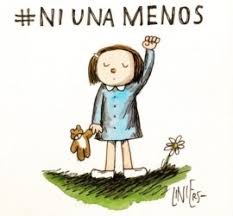Ilustración: Carolina Leporace.
 El presente artículo se basa en un análisis del texto periodístico "La cautiva" de María Pía López, a partir de algunas categorías de la Antigua Retórica, retomada por Roland Barthes, y de la Nueva Retórica, de Chaïm Perelman. El trabajo contempla el contexto social del cual emerge el texto, analizado en relación a determinados movimientos feministas, el fenómeno de los femicidios en Argentina y la violencia de género. Esta investigación incluye un análisis contextual, un sucinto recorrido explicativo de la Antigua y la Nueva Retórica, la aplicación de categorías como dispositio, clases de argumentos, auditorio y ethos en el análisis y una consideración de la importancia del abordaje de textos feministas desde las retóricas. El alcance de este trabajo radica en que el análisis de "La cautiva" contribuye a visibilizar y evaluar una argumentación que profundiza el debate sobre el patriarcado actual.
El presente artículo se basa en un análisis del texto periodístico "La cautiva" de María Pía López, a partir de algunas categorías de la Antigua Retórica, retomada por Roland Barthes, y de la Nueva Retórica, de Chaïm Perelman. El trabajo contempla el contexto social del cual emerge el texto, analizado en relación a determinados movimientos feministas, el fenómeno de los femicidios en Argentina y la violencia de género. Esta investigación incluye un análisis contextual, un sucinto recorrido explicativo de la Antigua y la Nueva Retórica, la aplicación de categorías como dispositio, clases de argumentos, auditorio y ethos en el análisis y una consideración de la importancia del abordaje de textos feministas desde las retóricas. El alcance de este trabajo radica en que el análisis de "La cautiva" contribuye a visibilizar y evaluar una argumentación que profundiza el debate sobre el patriarcado actual.
Abstract
The present article is based on an analysis of the journalistic text "The Captive" of María Pía López, starting from some categories of the Old Rhetoric, taken over by Roland Barthes, and the New Rhetoric by Chaïm Perelman. The paper looks at the social context from which the analyzed text emerges, in relation to certain feminist movements, the phenomenon of femicides in Argentina and gender violence. This research includes a contextual analysis, a brief explanation of the Old and New rhetoric, the application of categories such as dispositio, classes of arguments, audience, ethos in the analysis and a consideration of the importance of approaching feminist texts from rhetoric. The scope of this work is that the analysis of "The Captive" helps to visualize and evaluate an argument that deepens the debate on the current patriarchy.
[1]Este trabajo ha sido producido en el marco de la asignatura Teoría y Práctica de la Lectura y la Escritura II, del Profesorado y la Licenciatura en Letras, Facultad de Humanidades, UNComahue, 2017.


